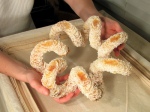 I love the concept of 3D printing. Of course, I also really enjoy teaching Calc II when we talk about slicing and shell formulas and volumes of revolution, because I remember the AHA! moment when I suddenly put together what the formulas were all describing and it all made perfect sense. (Sadly, this moment came when I was a senior studying for comps, several years after actually taking the class, but still, AHA! moments are glorious.)
I love the concept of 3D printing. Of course, I also really enjoy teaching Calc II when we talk about slicing and shell formulas and volumes of revolution, because I remember the AHA! moment when I suddenly put together what the formulas were all describing and it all made perfect sense. (Sadly, this moment came when I was a senior studying for comps, several years after actually taking the class, but still, AHA! moments are glorious.)
In 3D printing, objects are built from the bottom up, cross section by cross section, the same way you’re supposed to envision the pieces when you calculate volumes by slicing. This article in the Christian Science Monitor last week likens it to building with legos, although my experience with legos is that separate sections are constructed and then put together (you build the walls, then add the furniture, then the roof); that concept might work with printing too, where you print separate components and then put them together. And what’s amazing is that you can print some pretty complicated things with moving parts.
So what is used for the printing? The article above describes a layer of powder being put down and the printing is actually done by spraying glue instead of ink. Wikipedia also describes printers that build with a liquid gel. But my favorite is printing done with candy.
That’s right: candy. Not surprisingly, the CandyFab 6000 and it’s earlier prototypes are made by the folk at Evil Mad Scientist Laboratories. Here’s an example of 3D printing:
Isn’t that amazing? Here’s the machine it was done on:
You can see it making some 3D Candy above. They keep making improvements, as you can see in the two dodecahedrons below (printed at different times):
Here’s another fancy piece o’ printing:
And finally, here’s a Möbius Strip. I thought it was a cake at first but no, it’s eight pounds of sugar.
Now that’s some pretty neat printing. You can even see the “slices” on the surface.
All photos are licensed under Creative Commons; the photos link to their home on Flickr, and you can find even more here, plus more information here.





June 18, 2009 at 9:32 pm |
Yes! I love this visual, too. I first found out about the concept while watching the movie “Small Soldiers” (about some toys that come to life and fight each other threatening their owners). During the opening credits, they show the creation of the toys by pointing a laser at a vat of goo and the toys are printed right out of it. I used to rent the movie just for that 10 second clip to show my classes the visuals of cross-sectional areas stacking to form 3D objects.
Anyhow, if you have Netflix or a free blockbuster coupon or something, you might check it out (the movie itself isn’t horrible, but not amazing either).
June 19, 2009 at 3:46 pm |
You are probably already familiar with the slice forms that John Sharp designs. They also provide great visual and tactile (but not edible) demonstrations of the calculus concepts you mentioned. And you don’t need a CandyFab 6000. Nice pointers to Sharp’s work are found on this post from the Travels in a Mathematical World blog:
http://travelsinamathematicalworld.blogspot.com/2009/04/podcast-episode-24-john-sharp-maths-and.html
June 19, 2009 at 8:12 pm |
David and Dan — thanks for the heads up about the videos!
June 21, 2009 at 1:52 pm |
If you’re interested in following the news on 3D Printing and digital fabrication, you might consider reading our blog at Fabbaloo or http://fabbaloo.com
October 23, 2009 at 3:41 pm |
This has to be one of the craziest things I’ve ever seen. Is this stuff edible?
December 10, 2009 at 10:04 pm |
[…] threesixty360.wordpress.com December 10th, 2009 | Tags: 3D Printers & Supplies, 3d printing, 3d printing technology, ink […]